Car Accidents
More than 7 million vehicle crashes happened in the United States in 2016. A total of 34,439 accidents resulted in deaths and about 2.2 million caused injuries, according to the National Highway Traffic Safety Administration. The National Safety Council estimates roughly 40,000 people died in car accidents a year from 2016 through 2018.

Passenger cars, SUVs and light trucks made up about 93 percent of all vehicles in the United States in 2016 and accounted for roughly 90 percent of all vehicle miles traveled. They also represented 78 percent of the vehicles involved in fatal crashes, according to the National Highway Traffic Safety Administration.
Nearly one in three Americans have had a relative who was seriously injured or killed in a car accident, according to the AAA Foundation.
Carmakers have been adding an ever-growing array of new vehicle safety features to new cars, including side impact airbags and crash avoidance warnings. But after years of declining fatalities, the number of traffic-related deaths has increased over the last few years.
Understanding your risks on the road, how accidents happen and what you can do to avoid or prevent them can help keep you safer behind the wheel.
Top Causes of Car Crashes
Three simple things can improve everyone’s chances of staying alive on the road. Driving sober, following the speed limit and making sure everyone in your car is buckled are the best ways to prevent fatal accidents.
All three factor into the largest numbers of fatal accidents.
Speeding Kills an Average of 10,000 Americans a Year
More than half of drivers admitted to driving at least 15 mph over the speed limit on freeways in a 2017 AAA Foundation survey. Nearly half said they topped 10 mph over the limit on residential streets.
People tend to speed due to traffic congestion, because they’re running late or out of disregard for the law. The National Highway Traffic Safety Administration considers speeding a form of aggressive driving.

Speeding creates several possible dangers that you may not be aware of. It increases your chances of losing control of your car and reduces the effectiveness of safety features in a crash. It can shorten the amount of time to you have to respond to a danger on the road while increasing the distance you need to stop. And higher speeds can cause much more severe injuries if you are in an accident.
You can reduce your risk of serious accidents if you avoid speeding and try to stay out of the way of speeders. Move to the right and let speeders pass if you see one approaching or tailgating you. And give speeders plenty of room so they don’t hit you in the event they lose control.
Drunk Driving Kills Almost 30 People Every Day in the United States
Alcohol affects your ability to drive in three ways. It impairs thinking, reasoning and muscle coordination. All are critical in avoiding car crashes. Drunk driving was a contributing factor in 10,874 deaths in 2017, according to the National Highway Traffic Safety Administration.

In setting drunk driving laws, most states limit drivers to a blood alcohol concentration, or BAC, of .08. That means a driver can have no more than .08 grams of alcohol per one-tenth of a liter of blood. But even this amount can make a driver deadly behind the wheel.
A person with a BAC level of .08 will already experience poor muscle coordination and judgement. He or she will be less likely to notice danger and will be less capable of reasoning and maintaining self-control.
For a driver, this means trouble concentrating and controlling the car’s speed. It means being less likely to notice brake lights, traffic signs and lights, and other traffic safety signals.
Buckling Up Saved Nearly 15,000 Lives In 2017
Seatbelts may be your best defense against speeders, drunk drivers and other dangers on the road. It’s estimated that seatbelts saved 14,955 lives in 2017.
Only about 90 percent of drivers and passengers buckle up. If everyone did, it could have saved an additional 2,549 lives in 2017, according to the National Highway Traffic Safety Administration.

Seatbelts work in several different ways to keep you safe. They prevent you from being thrown from the vehicle in an impact or rollover crash. They also keep you from being thrown into a rapidly expanding airbag during a crash. That amount of force can kill you.
And seatbelts can help prevent an accident. They can keep you from losing control of your car by holding you in position to use the steering wheel, brake and gas pedals if you suddenly have to maneuver sharply.
Distracted Driving Is a Growing Worry
Distracted driving was a factor in only 9 percent of fatal crashes in 2016, but it is one of the fastest growing concerns about car safety, according to the AAA Foundation.
A 2018 survey from the foundation found that nearly 58 percent of people considered talking on a cellphone while driving to be a serious threat. And 78 percent of people said texting and driving is a major hazard. But nearly 35 percent said they have sent a text or email while driving and nearly half of drivers reported recently talking on a hand-held cellphone while behind the wheel.

Distracted driving includes any activity that takes your eyes off the road. Cellphone use was responsible for 14 percent of fatal distracted-driving accidents in 2016, according to National Highway Traffic Safety Administration.
The agency estimates that 391,000 people — or 16 percent of all people injured in crashes — were injured in crashes caused by distraction in 2015. It warns that taking your eyes off the road for just 5 second can be fatal. If you’re driving at 55 mph, you’ll travel the length of a football field in that time.
Leading Types of Car Accidents and How to Prevent Them
The most common types of car accidents usually have several things in common. They may occur if your field of view or reaction time is limited.
You may be able to plan ahead for those situations. If you know what to look for, you can take steps to reduce your risk of being in an accident.
Rear End Collisions
Rear end collisions are among the most common types of car crashes. They can happen because someone is following too closely and doesn’t have time to react when the car in front stops suddenly. Or they can happen when a line of cars is merging and a driver is looking for an opening instead of the traffic in his or her lane.
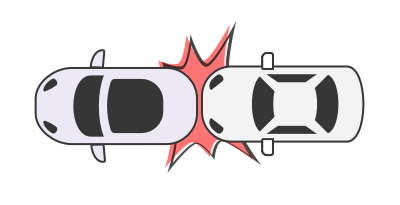
How to Prevent Them
Give yourself plenty of distance between your car and the car in front of you. If someone is tailgating, slow down to minimize injuries in the event of a crash and move to the right to let them pass when it’s safe.
Side Impact (“T-Bone”) Collisions
T-bone crashes generally happen at intersections, but they can also happen when one car sideswipes another. They account for about a quarter of all serious crashes. They can happen when you make a left-hand turn because your view of oncoming traffic is blocked by a vehicle facing you. Or you may be overwhelmed at a busy intersection, watching to the left and unaware of a vehicle, cyclist or pedestrian approaching from your right.
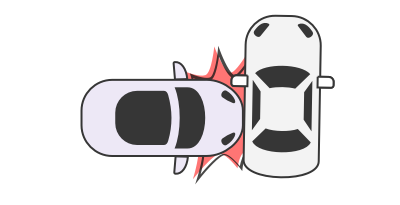
How to Prevent Them
Be extra aware of your surroundings at stop signs and lights. Avoid racing to beat a red light. Don’t make rolling turns on red; always come to a complete stop first and look both ways before making a right turn on red. And check all your blind spots before changing lanes to avoid a sideswipe.
Front Impact Collisions
Front impact collisions include head-on collisions and anytime the front of a car impacts an object like a tree or telephone pole. They account for more than half of all serious car crashes. They may be caused by distracted driving, drowsy driving or slippery roads.
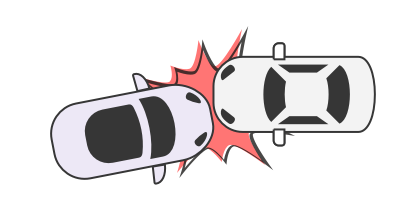
How to Prevent Them
Pay attention to the road and avoid distractions like answering cellphone calls, reading or sending texts, eating messy food or watching your passengers. Slow down in rain or winter weather that may make the road slick. This will give you more time to react and a shorter stopping distance if you need it.
Parking Lot (Low-Speed) Collisions
Fender benders in parking lots or hitting parked cars account for a surprising number of car crashes. They generally happen because you can’t see traffic around your parking space or you aren’t paying attention to parked cars.
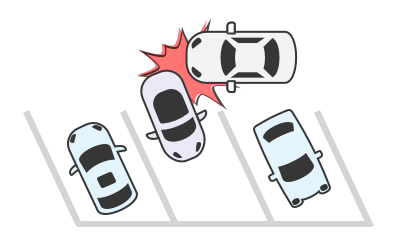
How to Prevent Them
If you’re leaving a parking spot, check out your surroundings before getting into your car. If you can’t see around the other parked cars, help other cars and pedestrians see you. Turn on your lights to make your car more visible as you pull out. Tap your horn twice before backing out to alert pedestrians that you’re moving.
Hydroplaning
Hydroplaning can happen when you move so fast on rain-slick roads that your tires are actually floating on a thin layer of water instead of the road. This can cause you to lose control of your car.
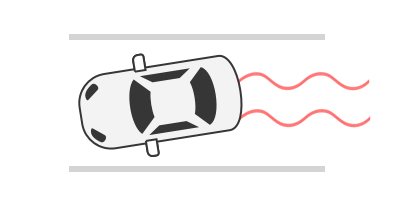
How to Prevent It
If you feel yourself hydroplaning, take your foot off the gas but do not hit the brake or steer sharply. Apply slow, steady pressure to the brakes or allow the car to slow down as it coasts. This will let the tires come back into contact with the pavement.
Animal Collisions
Colliding with large animals can cause serious damage and injuries. Deer crashes are extremely common at certain times of the year on rural and suburban roads.
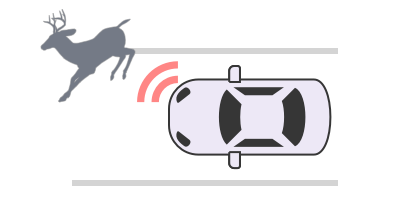
How to Prevent Them
Be aware of your surroundings, especially when driving in areas with woods or grassland. Wear seatbelts and follow speed limits. And drive with your high beams on at night in rural areas if there is no oncoming traffic or cars immediately in front of you. Give yourself time to slow down or stop if an animal runs out in front of you. But be careful of trying to avoid an impact if a sudden turn would take you into oncoming traffic or trees, or cause you to lose control of your car.
What to Do If You Are in a Car Accident
Fatal accidents were only a small fraction of the nearly 7.3 million traffic crashes reported to police in 2016. Those crashes injured more than 2 million people.
Injuries from car accidents can be expensive. The Centers for Disease Control and Prevention estimates that car crashes accounted for $18 billion in lifetime medical costs in 2012.
| When and Where Most Car Accidents Happen | |
|---|---|
| Turning at or crossing an intersection | 36 percent |
| Running off the edge of a road | 22 percent |
| Stopped in traffic | 12 percent |
| Crossing into another lane | 11 percent |
| After driver lost control on road | 9 percent |
Source: National Highway Traffic Safety Administration National Motor Vehicle Crash Causation Survey Report to Congress
More than one in five drivers have been involved in a vehicle crash severe enough to send someone to the hospital, according to the AAA Foundation. And even more have likely been involved in minor accidents that caused only property damage.
Regardless of how severe a car accident is, you should know what to do if you are involved in one. It’s a good idea to have a checklist in you glovebox or console. Even a parking lot fender bender can leave you stunned, confused or embarrassed.
More than one in five drivers have been involved in a vehicle crash severe enough to send someone to the hospital, according to the AAA Foundation. And even more have likely been involved in minor accidents that caused only property damage.
Regardless of how severe a car accident is, you should know what to do if you are involved in one. It’s a good idea to have a checklist in you glovebox or console. Even a parking lot fender bender can leave you stunned, confused or embarrassed.
- Move to a safe place if possible.
- Check yourself and passengers for injuries.
- Provide first aid if needed.
- Call 911 is someone needs medical care.
- Call the police and report the accident.
While Still at the Scene
- Gather as much information as possible.
- Get the name, phone number, insurance information and license plate number of other drivers and passengers.
- Take photos of damage to all vehicles and the location.
- Get the name, badge number and a phone number from any police officer you talk to.
- Contact your insurance company.
You should also be aware of the potential of a car accident lawsuit stemming from the crash. That means you should be careful about your behavior and what you say after an accident.
You should keep calm and not raise your voice or argue with other people involved in the accident. You should also not claim the accident was your fault, say your insurance will cover damages or anything else that could place you at fault.
27 Cited Research Articles
Consumernotice.org adheres to the highest ethical standards for content production and references only credible sources of information, including government reports, interviews with experts, highly regarded nonprofit organizations, peer-reviewed journals, court records and academic organizations. You can learn more about our dedication to relevance, accuracy and transparency by reading our editorial policy.
- AAA Foundation for Traffic Safety. (2018, March). 2017 Traffic Safety Culture Index. Retrieved from https://aaafoundation.org/2017-traffic-safety-culture-index/
- AAA Foundation for Traffic Safety. (2018, March). 2017 Traffic Safety Culture Index Fact Sheet. Retrieved from https://publicaffairsresources.aaa.biz/wp-content/uploads/2018/03/AAAFTS-TSCI-Fact-Sheet.pdf
- Automotive Training Center. (n.d.). Most Common Types of Car Accidents You’ll See as an Auto Appraiser. Retrieved from https://www.autotraining.edu/blog/most-common-types-car-accidents-auto-appraiser/
- California Department of Insurance. (2018, June). So You’ve had an Accident, What’s Next? Retrieved from https://www.insurance.ca.gov/01-consumers/105-type/95-guides/01-auto/hadaccident.cfm
- Casner, S. (2017, November 21). Anatomy of a Car Crash. Slate. Retrieved from https://slate.com/technology/2017/11/the-six-main-causes-of-car-crashes.html
- Esurance. (n.d.). What To Do After A Car Accident: A Step-By-Step Guide. Retrieved from https://www.allstate.com/tr/car-insurance/in-case-of-a-car-accident.aspx
- Johnson, T. (2018, March 29). Distraction Tops Drivers’ List of Growing Dangers on the Road. American Automobile Association. Retrieved from https://newsroom.aaa.com/2018/03/distraction-tops-drivers-list-growing-dangers-road/
- King, E.L. (2017, December 6). Top 15 Causes of Car Accidents and How You Can Prevent Them. HuffPost. Retrieved from https://www.huffpost.com/entry/top-15-causes-of-car-accidents_b_11722196
- National Safety Council (2019, February 14). NSC: Motor Vehicle Deaths Reach 40,000 for Third Straight Year in 2018. News Release. Retrieved from https://www.safetyandhealthmagazine.com/articles/18048-nsc-motor-vehicle-deaths-reach-40000-for-third-straight-year-in-2018
- National Safety Council. (2019, February 14). Preliminary Estimates. Retrieved from https://injuryfacts.nsc.org/motor-vehicle/overview/preliminary-estimates/
- O’Connor, R. (2018, March 28). 4 Common Collisions and How to Avoid Them. GEICO. Retrieved from https://www.geico.com/living/driving/auto/car-safety-insurance/common-collisions
- Smith, B.W. (2013, December 18). Human Error as a Cause of Vehicle Crashes. Center for Internet and Safety, Stanford Law School. Retrieved from http://cyberlaw.stanford.edu/blog/2013/12/human-error-cause-vehicle-crashes
- U.S. Centers for Disease Control and Prevention. (2014, October 7). Motor Vehicle Crash Injuries. Retrieved from https://www.cdc.gov/vitalsigns/crash-injuries/index.html
- U.S. Centers for Disease Control and Prevention. (2016, July 6). Motor Vehicle Crash Deaths; How is the U.S. Doing? Retrieved from https://www.cdc.gov/vitalsigns/motor-vehicle-safety/
- U.S. National Highway Traffic Safety Administration. (2007, October). Analyses of Rear-End Crashes and Near-Crashes in the 100-Car Naturalistic Driving Study to Support Rear-Signaling Countermeasure Development. Retrieved from https://www.nhtsa.gov/sites/nhtsa.dot.gov/files/analyses20of20rear-end20crashes20and20near-crashes20dot20hs2081020846.pdf
- U.S. National Highway Traffic Safety Administration. (2008, July). National Motor Vehicle Crash Causation Survey. Report to Congress. Retrieved from https://crashstats.nhtsa.dot.gov/Api/Public/ViewPublication/811059
- U.S. National Highway Traffic Safety Administration. (2015, February). Critical Reasons for Crashes Investigated in the National Motor Vehicle Crash Causation Survey. Retrieved from https://crashstats.nhtsa.dot.gov/Api/Public/ViewPublication/812115
- U.S. National Highway Traffic Safety Administration. (2017, October 6). USDOT Releases 2016 Fata Traffic Crash Data. News Release. Retrieved from https://www.nhtsa.gov/press-releases/usdot-releases-2016-fatal-traffic-crash-data
- U.S. National Highway Traffic Safety Administration. (2017, October 6). 2016 Fatal Motor Vehicle Crashes: Overview. Retrieved from https://www.nhtsa.gov/press-releases/usdot-releases-2016-fatal-traffic-crash-data
- U.S. National Highway Traffic Safety Administration. (2017, October 6). Quick Facts 2016. Retrieved from https://www.nhtsa.gov/press-releases/usdot-releases-2016-fatal-traffic-crash-data
- U.S. National Highway Traffic Safety Administration. (2018, April). Distracted Driving 2016. Retrieved from https://crashstats.nhtsa.dot.gov/Api/Public/ViewPublication/812517
- U.S. National Highway Traffic Safety Administration. (2018, September). Summary of Motor Vehicle Crashes. Retrieved from https://crashstats.nhtsa.dot.gov/Api/Public/ViewPublication/812580
- U.S. National Highway Traffic Safety Administration. (n.d.). Distracted Driving. Retrieved from https://www.nhtsa.gov/risky-driving/distracted-driving
- U.S. National Highway Traffic Safety Administration. (n.d.). Drunk Driving. Retrieved from https://www.nhtsa.gov/risky-driving/drunk-driving
- U.S. National Highway Traffic Safety Administration. (n.d.). Seat Belts. Retrieved from https://www.nhtsa.gov/risky-driving/seat-belts
- U.S. National Highway Traffic Safety Administration. (n.d.). Speeding. Retrieved from https://www.nhtsa.gov/risky-driving/speeding
- Vincent, J.M. (2018, March 1). What Should You Do if You’re in a Car Accident? U.S. News & World Report. Retrieved from https://cars.usnews.com/cars-trucks/what-to-do-if-youre-in-a-car-accident
Calling this number connects you with a Consumer Notice, LLC representative. We will direct you to one of our trusted legal partners for a free case review.
Consumer Notice, LLC's trusted legal partners support the organization's mission to keep people safe from dangerous drugs and medical devices. For more information, visit our partners page.
844-420-1914
